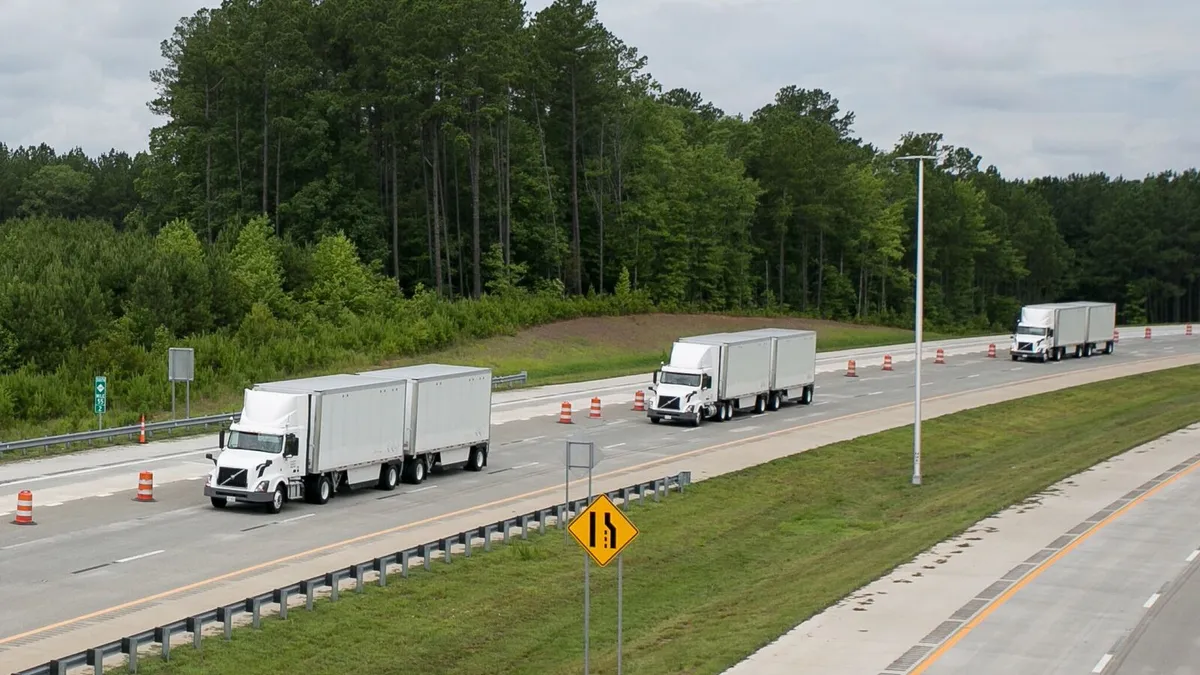Dive Brief:
- Three Volvo VNL tractors pulling 28-foot trailers conducted a public on-highway display of truck platooning technology Wednesday on North Carolina's Triangle Expressway (N.C. 540), according to a press release.
- The showcase, conducted jointly by FedEx and Volvo, was the first of its kind in North Carolina. The trucks were equipped with Volvo's Cooperative Adaptive Cruise Control (CACC), a wireless vehicle-to-vehicle technology that allowed tractors to maintain a closer following distance than typically possible at 62 mph.
- FedEx and Volvo have been testing the technology in North Carolina since April 2018. The companies are researching how platooning can provide "faster responses to hard braking while maintaining safety and fuel efficiency."
Dive Insight:
"Like any emerging technology, the future of truck platooning will ultimately be decided by the market and companies embracing platooning as part of their operations," Keith Brandis, vice president of product planning at Volvo Trucks North America, told Supply Chain Dive in an email.
This week's public tests, then, are a bit of a breakthrough. It marks "the first live, on-highway platooning technology demonstration between a global transportation and logistics provider and a trucking OEM in the United States," Jennifer Caccavo Cordeau, a FedEx spokesperson, told Supply Chain Dive in an email.
With FedEx and Volvo collaborating, it boosts the likelihood the technology will go to market not just in North Carolina, but at a global scale.
Already the benefits of truck platooning are becoming clear. Transportation providers are always looking for ways to reduce fuel costs, due to a fickle oil market. About 25% of a truck's fuel consumption comes from "drag," but platooning — due to closer following distance — helps reduce this.
Other benefits include improved highway utilization that could help traffic congestion, and faster braking speed as trucks automatically communicate their speeds with each other. "The advanced technology is meant to serve as an aid — not a replacement — for skilled professional truck drivers," according to the press release.
However, significant obstacles remain for adoption despite the industry's interest in technology.
Vehicle-to-vehicle communication relies on dedicated short-range communication (DSRC) technology. This, in turn, requires "dedicated bandwith within the 5.9 GHz spectrum" for successful deployment of truck platooning, Brandis said in a statement.
"There are also regulatory obstacles to implementing this technology on a broader scale as well," Caccavo Cordeau said.
"Rollout of truck platooning will require states to approve provisions for closer following distances, and few have taken the necessary steps at this time to allow for truck platooning," Brandis added.
N.C. 540 is one of the 10 sites designated by the DOT to test the new technology in the United States. Similar tests have taken place in Iowa, Nevada and Oregon.















